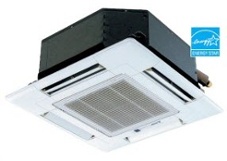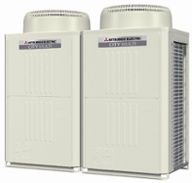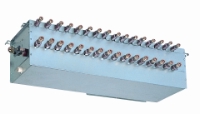The Ductless Mini-Split Heat Pump’s Big Brother – CITY MULTI

 In my last four HVAC Design jobs, I’ve specified ductless mini-split heat pumps. I have four more such jobs underway now.
In my last four HVAC Design jobs, I’ve specified ductless mini-split heat pumps. I have four more such jobs underway now.
In my last four HVAC Design jobs, I’ve specified ductless mini-split heat pumps. I have four more such jobs underway now.
Why mini-splits?
- Efficiency (up to 26 SEER)
- Variable Refrigerant Flow
- Versatility
- No Ducts!
In fact, some say they’re threatening to replace the standard forced air HVAC systems that we’ve grown to lo…well, that we’ve grown accustomed to. Allison’s post about the advantages of these mini-split heat pumps explains some of the other reasons why they’re becoming so popular.
Diamond Designer
At a recent Mitsubishi Diamond Designer training, I learned more about the mini-split’s big brother, the CITY MULTI system by Mitsubishi Electric HVAC, and how to design it for multi-family and commercial buildings. It uses the same efficient technology as mini-splits, but on a larger scale. In fact, we recently looked at a 250-unit high rise condominium retrofit project where CITY MULTI would replace a tired, inefficient boiler and chiller system from the 1960’s. CITY MULTI’s pipes are no bigger than 3″ with insulation, so the lines will be small enough that the team won’t have modify the structure much at all.
The WHAT and the HOW
 CITY MULTI is a 2-pipe, modular heat pump system that takes advantage of special compressors that can feed up to 50 different zones. It also can do simultaneous heating and cooling.
CITY MULTI is a 2-pipe, modular heat pump system that takes advantage of special compressors that can feed up to 50 different zones. It also can do simultaneous heating and cooling.
The 2 pipes are the refrigerant lines that run from an outdoor condensing unit to either a BC Controller or Branch Header. From there, soft copper, pre-insulated line-sets are used to deliver the cold or hot refrigerant to individual fan coils that are placed within each zone that requires heating or cooling. With the simultaneous heating and cooling system, the same refrigerant which is used to heat one zone can be pumped to another zone with a need for cooling. This offers both increased energy efficiency and comfort over other types of HVAC systems.
 Depending on the series (R2, WR2, Y, WY, H2i, & S), systems can be designed for up to 30-tons of capacity, using 6, 8, 10, or 12-ton modular condensers piped together. These systems can also have over 100% connected capacity, in some cases up to 150% of their condensing unit rated capacity because of the systems greatest asset: Variable Refrigerant Flow/Volume (VRF or VRV).
Depending on the series (R2, WR2, Y, WY, H2i, & S), systems can be designed for up to 30-tons of capacity, using 6, 8, 10, or 12-ton modular condensers piped together. These systems can also have over 100% connected capacity, in some cases up to 150% of their condensing unit rated capacity because of the systems greatest asset: Variable Refrigerant Flow/Volume (VRF or VRV).
VRF/VRV allows a system to adjust the amount of refrigerant delivered by the compressors to provide only the amount of heating or cooling to a zone that is required at any given time within the limits of the designed peak load. It does this through the use of a Linear Expansion Valve (LEV) that controls the refrigerant flow to each indoor unit. Through 3 on-board thermistors, the indoor unit constantly monitors the space and refrigerant conditions and communicates to the LEV and the condensing unit to dial up or down the amount of refrigerant delivered to the coil.
 Controls vary as well but are very simple and integrated with the system. The indoor units can be controlled individually, by a central master controller, both, or by a PC-based system. Because the thermostats are within the indoor units, or heads, temperature is controlled remotely and the controls can be placed anywhere within the zone. They can be used to read the temperature in the room but are NOT a thermostat.
Controls vary as well but are very simple and integrated with the system. The indoor units can be controlled individually, by a central master controller, both, or by a PC-based system. Because the thermostats are within the indoor units, or heads, temperature is controlled remotely and the controls can be placed anywhere within the zone. They can be used to read the temperature in the room but are NOT a thermostat.
The Advantages
- Certain models offer 100% heating capacity down to 5° F. All the units are heat pump models that provide substantial low ambient heating capability typically eliminating the need for additional heating systems in most of the Southeast and even much farther north if properly designed.
- The inverter driven compressor uses only as much or as little energy as needed at any given point in time to maintain room conditions. This results in energy savings that have been in the range of 10% to 40% over other systems (based on actual retrofit results and project energy models)
- R-2 and Y series systems are compatible with both air cooled and water cooled configurations, and the water-cooled equipment CAN be used with geothermal applications
- Indoor fan coil options range from floor, wall, and ceiling mounted to floor, wall and ceiling concealed (ducted).
- Using their new Hydronic Heat Exchanger and Booster units, hot water can be created directly or through the use of recovered energy from cooling for large potential energy savings.
- Offers completely integrated ventilation options between 300 and 1200 CFM.
- First cost is competitive with water source heat pump systems and is better than four-pipe and geothermal systems.
In addition to commercial and multi-family projects, this could potentially be a great application in larger homes that have loads greater than 5 tons (and available 3-phase power).
This Post Has 9 Comments
Comments are closed.

City Multi is serious HVAC
City Multi is serious HVAC equipment. We used them on a 22,000 sq. ft starter castle a couple years back – 15 tons and 22 indoor units. Variable capacity softens the over sizing issue and it was much easier to zone using multi units rather than conventional dampers.
A couple disadvantages we found were 1/2 mile of copper refrigerant line can get expensive with copper prices going up 20% at a time. This is not something that Bubba and Earl Heatin and Coolin will be able to diagnose and repair.
Great article. I am very
Great article. I am very interested in learning more. Tell me more about the training.
Danny,
Danny,
You are so right on. This is a technology that will take time to become mainstream. Like so many new technologies, though, it will happen.
The HVAC Industry, as you know, continues going through a lot of upheaval because of energy efficiency. High Performance Homes are like a whole new playing field, and few understand how to design for it. The industry is almost being reinvented…literally.
Rules of thumb will eventually go away, and unfortunately for Bubba and Earl, those who jump on board are the ones who will survive.
Thanks for your comment!
Thanks, Jimmy! The class was
Thanks, Jimmy! The class was a great first step in to understanding the advantages of the technology. We also dove in to the design tool, and came out of having designed a commercial project. Phase 2 of the class is coming up soon where we will go in to the specifics of EnergyPro (energy modeling tool). They say it is the most compatible with CITY MULTI.
Chris,
Chris,
I am already envisioning wood working projects to disguise the (residential) indoor units of the mini-split as pieces of period furniture… 🙂
– John
This very much seems like the
This very much seems like the future of hvac. I’ve put a lot of systems in and this sounds like the one I would use.
The minisplit is just about
The minisplit is just about what I was looking for when I started my deep energy retrofit last summer (now complete, see blog for the excruciating details). What I wanted was a modulating geothermal heat pump (i.e. one that could turn on and off intermittently rather than run continuously to heat up a buffer tank) for our hydronic hot water system for heating in the winter, and that could be coupled to an HRV system for cooling fresh incoming air in the summer. Instead, what I was offered was a nonmodulating geothermal heat pump designed for extreme climates rather than our moderate climate here in California, an 80 gallon buffer tank to ease the load on the heat pump, and an air handling system for cooling that was completely separate from the HRV system. So I would have had to install two duct systems. I dropped the geothermal heat pump because the technology seemed too cumbersome and expensive, and we couldn’t figure out a way to accommodate 2 ducting systems in our house. With the minisplits, though, (if they could be coupled to a modulating geothermal heat pump) you could run the cooling lines to the HRV fans, and connect a separate set of lines for heating to the hydronic system. It does not completely eliminate ducts but with our house being extremely tightly insulated, some way is needed to get fresh air into the house and exhaust stale air (and the HRV systems work very well though we have not used them much so far because it is now warm enough to open the windows). This seems but a short step from the minisplit technology described here.
Same here kempf42, I also
Same here kempf42, I also wanted to modulate geothermal heat pumps as its the most efficient way to save money i guess. Just like your hometown here in New Zealand we need this heat pumps during winter season as its freezing in here I currently use fujitsu heat pumps may be my best choice for now but for the future i guess ill go with geothermal as they produce such thing.
I could not agree more. Every
I could not agree more. Every application in which we have used a ductless mini-split system, it has provided exceptional perfomance at a comparatively low cost. They are very good systems and I think in time, people will not mind the aesthetic difference and they will be utilized in more homes.